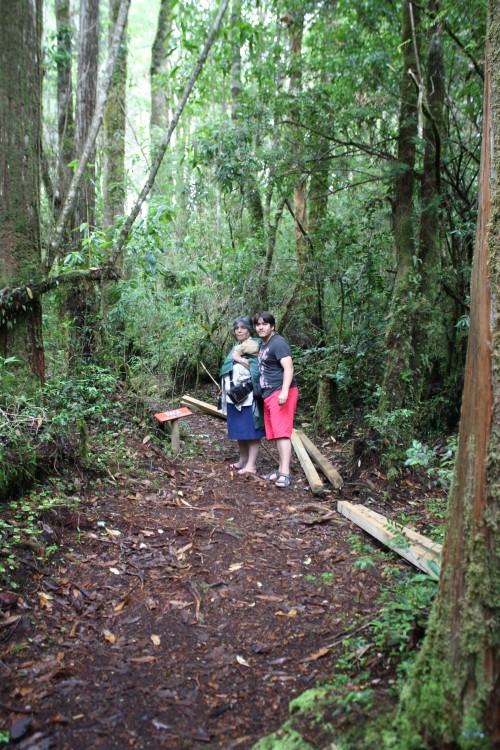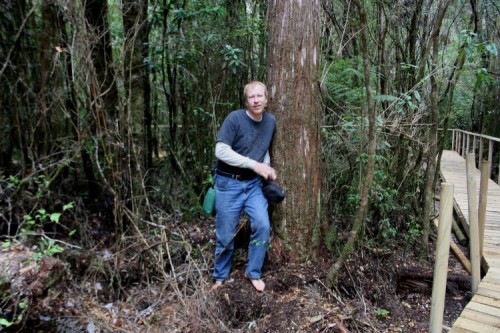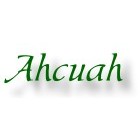Southern Chile, that is, the Puerto Montt area, is not only similar to northern California in climate, but it also has trees very similar to sequoias and redwoods. Well, similar climates produce similar responses.
In this case, it’s the alerce, or Fitzroy Cypress, also called the Patagonian Cypress.
I’ve written before that I’m quite fond of bald cypresses (I have about a dozen in my yard), so I was really looking forward to seeing these trees in my trip to Puerto Montt. The major location where they still remain (they were heavily logged in the past, and are now a protected species) is the Parque Nacional Alerce Andino, but we had trouble fitting in a visit while we were there.
However, there was another patch closer by, the Lahuen Ñadi Natural Monument, that I did manage to get to, thanks to the generosity of Machi’s wife Virginia.
The alerce is actually in a different subfamily of the Cupressaceae family that bald cypresses. Bald cypresses are in Taxodioideae while the alerce is in Fitzroya. Redwoods, giant sequoias, and dawn redwoods (I have one of those in my yard, too) are in the related subfamily Sequoioideae. But they are all similar.
By the way, “alerce” comes from the same Latin root as the word “larch”.
We actually had a bit of trouble finding the place, even though it was, as the crow flies, only about 6 miles from Machi’s house. None of his family had ever been there before, and the online instructions I was able to find didn’t say much. The official web page for Lahuen Ñadi does, however, point to the Google Map that shows where it is.
It turns out that Google is wrong. They’ve marked the wrong place.
We spent a fair bit of time driving up the wrong road without seeing a sign of the park and then had to turn around and try to find it for real. We eventually did, so anybody who is trying to find Lahuen Ñadi, this is where it really is (using the Google satellite view of the area).
[Click for larger version.]
Once we finally found the place and got there (41º24’44″S, 73º01’44″W), we did get a brochure with a very tiny map on it that does show the correct location, but it sure didn’t help us get there. The brochure also had the helpful hint that to get to the park “el acceso principal se realiza desde la entrada al condominio Lagunitas”. The main access is from the entrance to the Lagunitas subdivision.
But we made it, and it was a magical place.
“Lahuen” is the native Mapuche word for the alerce. And “Ñadi” is a word for the kind of swamp that the alerce grows in. As the brochure puts it,
El sector está situado en suelos volcánicos del tipo ñadi, los que se caracterizan por ser muy húmedos en invierno y secos en verano. Generalmente son delgados y poseen una capa de suelo impermeable, rellenada con sedimento fluvioglaciales y depósitos volcánicos.
So, a ñadi is a special kind of swamp with an impermeable layer underneath and filled with glacial deposits and volcanic soils.
It doesn’t have solely alerces, but a bunch of plants that tolerate the ñadi soil. Here’s a Chilean Myrtle that was near the entrance.
As you can see, it was blooming.
There was also a small alerce near the entrance. That gave us a chance to see the leaves (because we sure as heck couldn’t see much of the leaves at the tops of the mature trees).
As you can see, the leaves are more scale-like like those of giant sequoias and less feather-like like those of redwoods or bald cypresses.
There was a fairly short, about a half-mile, boardwalk trail through the forest. It was fairly dry while we were there, but that’s fairly typical of the ñadi swamp: it tends to be dry in the summer and very wet in the winter. Where the trail split to make a loop, we encountered our first large alerce and I couldn’t resist showing its size by doing my best George of the Jungle impression.
Oops. Wrong picture.
It’s a really slow growing tree, so that one could be something like 500-900 years old.
This picture, with Virginia and Lucas, gives you a feel for the boardwalk and the look of the forest and soil.
Some of the boardwalk was being reconstructed, so we also got to walk directly on the soil (a joy for any barefooter).
The alerce species has the second oldest living tree, a 3600-year old specimen, but that wasn’t at Lahuen Ñadi. There, the oldest tree is a mere 1,600 years old. You could spot it, though, as you approached it from the distance.
And here’s the base.
It has the marvelous bark of all the related trees. You can see that this one is a bit hollowed-out, but the tree is still doing fine. The wood, unsurprisingly, is quite resistant to rot.
And here’s the view up the tree.
I mentioned before what a joy the soil of the ñadi was to feel with one’s bare feet (oh, what the shod are missing out on). Here I am in front of a real “youngster” sampling the ñadi.
Between the lahuen and the ñadi, this is a very special place, made all the more special by being hard to find and out of the way, even though it is not far outside the city of Puerto Montt. It’s actually just off the road between the city and the airport.
I was really happy that we managed to make the special effort to get there. So were my feet.













There are some spectacular old trees (mostly cedar) in the Vancouver area. If you ever go there make sure you find out where they are (from me or from Clubtread.com) – you don’t want to miss them. The trails won’t be as well-maintained, though.
Round Canterbury we have genuine original cobbled roads dating back hundreds of years, including stone paving slabs that feel very nice. Like you say, they really have no idea what they are missing.